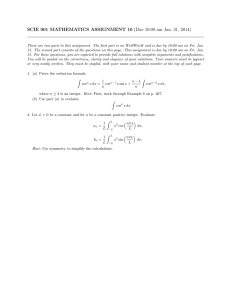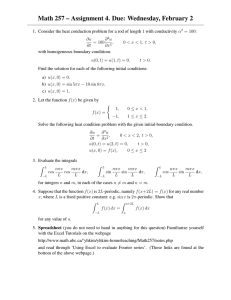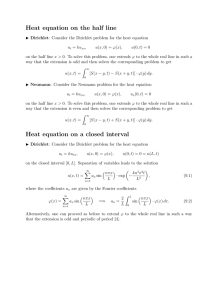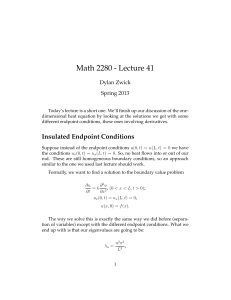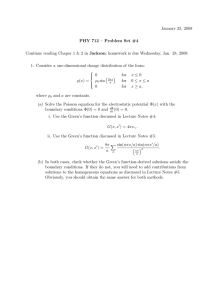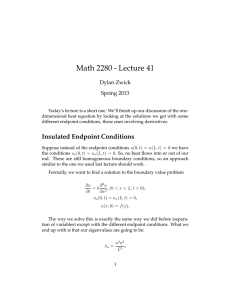Sections 3.1, 3.2 and handout
advertisement
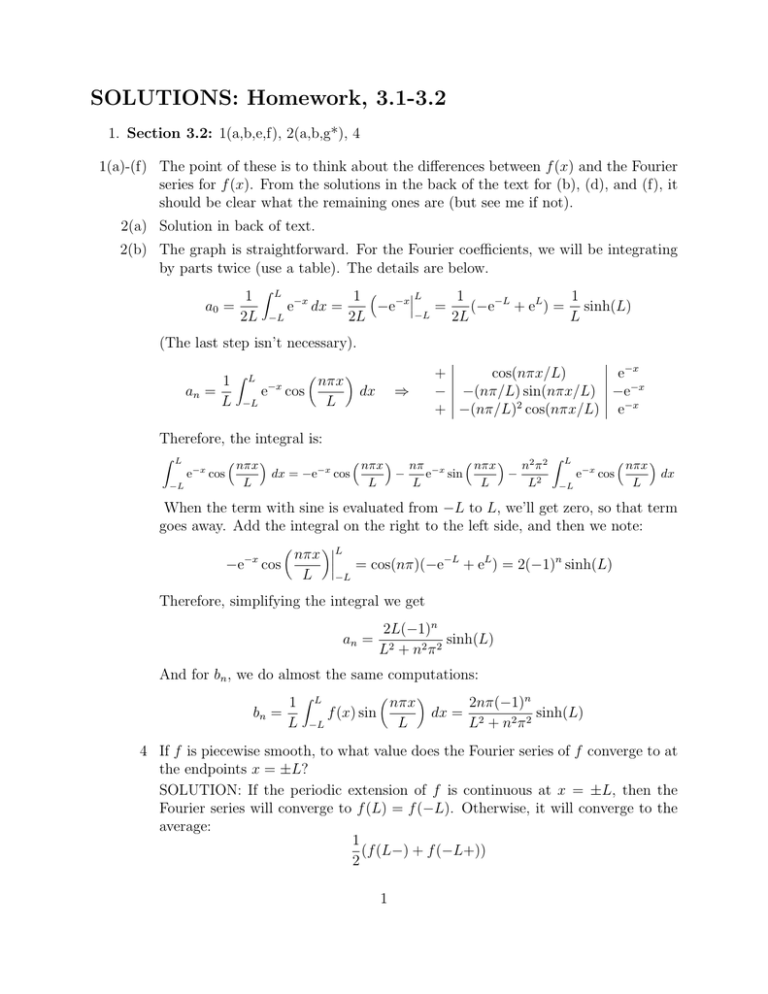
SOLUTIONS: Homework, 3.1-3.2 1. Section 3.2: 1(a,b,e,f), 2(a,b,g*), 4 1(a)-(f) The point of these is to think about the differences between f (x) and the Fourier series for f (x). From the solutions in the back of the text for (b), (d), and (f), it should be clear what the remaining ones are (but see me if not). 2(a) Solution in back of text. 2(b) The graph is straightforward. For the Fourier coefficients, we will be integrating by parts twice (use a table). The details are below. a0 = 1 1 −x L 1 1 Z L −x e dx = −e = (−e−L + eL ) = sinh(L) −L 2L −L 2L 2L L (The last step isn’t necessary). 1 Z L −x nπx an = e cos L −L L + cos(nπx/L) e−x − −(nπ/L) sin(nπx/L) −e−x + −(nπ/L)2 cos(nπx/L) e−x ⇒ dx Therefore, the integral is: Z L e −L −x cos nπx L dx = −e −x cos nπx L nπx n2 π 2 nπ −x e sin − − L L L2 Z L e−x cos −L nπx L dx When the term with sine is evaluated from −L to L, we’ll get zero, so that term goes away. Add the integral on the right to the left side, and then we note: −e −x nπx L = cos(nπ)(−e−L + eL ) = 2(−1)n sinh(L) cos L −L Therefore, simplifying the integral we get an = 2L(−1)n sinh(L) L2 + n2 π 2 And for bn , we do almost the same computations: 1ZL nπx bn = f (x) sin L −L L 2nπ(−1)n dx = 2 sinh(L) L + n2 π 2 4 If f is piecewise smooth, to what value does the Fourier series of f converge to at the endpoints x = ±L? SOLUTION: If the periodic extension of f is continuous at x = ±L, then the Fourier series will converge to f (L) = f (−L). Otherwise, it will converge to the average: 1 (f (L−) + f (−L+)) 2 1 2. Practice with the definitions: (a) Show that f is continuous, but not piecewise continuous and not piecewise smooth: f (x) = 1/x2 on (0, 1) SOLUTION: Since f is a rational function, f is continuous at every point in its domain, which is all reals except x = 0. We see that (0, 1) is in its domain, so f is continuous there. The function f is not piecewise continuous on (0, 1), because the limits at x = 0 (and x = 1) must also exist (and in this case, the limit at 0 does not exist). Similarly, f 0 (x) = −2x−3 , which is continuous on (0, 1), but not piecewise continuous (so that f is not piecewise smooth). (b) Show that f is not continuous, but is piecewise continuous and piecewise smooth. ( f (x) = x2 x2 + 1 if − π < x < 0 if 0 ≤ x < π SOLUTION: f is not continuous at the origin, since the limits from the right and left do not match. However, f is piecewise continuous since the limits do exist there. Similarly, the derivative is: ( 0 f (x) = 2x 2x if − π < x < 0 if 0 < x < π We note that f is not differentiable at x = 0 since f is not continuous there. However, the limits from the right and left exist at x = 0, so f 0 is piecewise continuous and is piecewise smooth. (c) (*) In this case, show that f is continuous on the interval and f 0 (x) exists for every x in the interval, but f is not piecewise smooth (focus on the origin). ( f (x) = x2 sin(1/x) 0 if x 6= 0 if x = 0 on the interval − π ≤ x ≤ π SOLUTION: See HW solutions. (d) If f, g are piecewise smooth, show that f + g and f g are both piecewise smooth. (Hint: Think about limit laws). SOLUTION: Since f is piecewise smooth, there is a partition of the domain, x0 , x1 , x2 , · · · , xn so that f is continuous on (xi , xi+1 ) and the limits exist at each xi . Similarly, there is a partition of g. 2 The partition for f + g and f g would include all the points from f and all the points from g. Then, (f + g) and f g would be continuous on each interval and the limits would each exist, since lim f + g = lim f (x) + lim g(x) x→a x→a x→a lim f g = lim f (x) lim g(x) x→a x→a x→a if the limits exist separately (and they do, since they are each piecewise continuous). A similar argument holds for the derivatives, since (f + g)0 = f 0 (x) + g 0 (x) (f g)0 = f 0 (x)g(x) + f (x)g 0 (x) 3. Properties of even and odd functions. Answer (by proving your statement): (a) The product of an even function times an even function is? SOLUTION: The product is even- If F (x) = f (x)g(x) with f, g even, then: F (−x) = f (−x)g(−x) = f (x)g(x) = F (x) (b) The product of an even function times an odd function is? SOLUTION: The product is odd- If F (x) = f (x)g(x) with f even and g odd, then: F (−x) = f (−x)g(−x) = f (x)(−g(x)) = −F (x) (c) The product of an odd function times an odd function is? SOLUTION: The product is odd- If F (x) = f (x)g(x) with f, g odd, then: F (−x) = f (−x)g(−x) = (−f (x))(−g(x)) = F (x) (d) What is Z L f (x) dx, if f is odd? −L SOLUTION: If f is odd, the integral is zero, since: Z L f (x) dx = f (x) dx + −L −L (e) Show that Z 0 Z L Z L f (x) dx = − 0 f (x) dx = 2 −L Z L Z L f (x) dx + Z L 0 f (x) dx = 0 0 f (x) dx, if f is even: 0 SOLUTION: If f is even, then f (−x) = f (x), and Z 0 f (x) dx = − Z 0 −L −L f (−x) dx = Z L f (x) dx 0 4. Making a function even and odd: Suppose f (x) is defined on the interval [0, L]. Then we can make f odd on the interval [−L, L] by defining g: ( g(x) = −f (−x) f (x) 3 if − L ≤ x < 0 if 0 ≤ x ≤ L Find a similar formula for making f even on [−L, L] if f is originally defined on [0, L]. SOLUTION: ( g(x) = f (−x) f (x) if − L ≤ x < 0 if 0 ≤ x ≤ L 5. Integration practice: For the first one, use the half angle (or double angle) formula. For the other two, use integration by parts. Z Z 1 1 1 (1 − cos(2nπx)) dx = x − sin(2nπx) + C 2 2 4nπ + x sin(nπx) 1 x ⇒ − 1 − cos(nπx)/(nπ) ⇒ − cos(nπx)− 2 2 sin(nπx)+C nπ nπ + 0 − sin(nπx)/(n2 π 2 ) sin2 (nπx) dx = x sin(nπx) dx Z For this one, integrate by parts twice to get the same integral on both sides, then simplify. I’ve included only the final answer below: Z e−2x sin(nπx) dx = −e−2x (nπ cos(nπx) + 2 sin(nπx)) + C 4 + n2 π 2 6. We said that if f is defined on [a, b), then the periodic extension of f is given by: f x− x−a (b − a) b−a For example, if f (x) = x2 on [−1, 3), what is f (7)? What is f (−2)? Check your answer graphically, and sketch the periodic extension of f . In fact, try it using Maple: f:=x->x^2; a:=-1; b:=3; plot(f(x-floor( (x-a)/(b-a) )*(b-a)),x=-3..10,discont=true); We said in class that we’re partitioning the real line into intervals: k = 0 Interval: [a, b) k = 1 Interval: [a + (b − a), a + 2(b − a)) k = 2 Interval: [a + 2(b − a), a + 3(b − a)) .. .. . . where k = b(x − a)/(b − a)c. Test this with a = −1, b = 3 and x = 2, then compute which interval x = 19 is in. SOLUTION: x = 19 is the left endpoint of the 5th interval (or right endpoint of the 4th interval). We can verify this by looking at the right endpoints: 3, 7, 11, 15, 19 4
